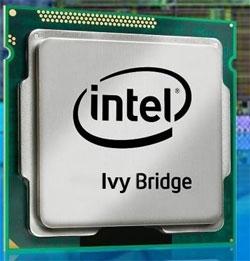
Intel kicked off this week by
announcing its third generation of core processors, Ivy Bridge. The first group includes 13 quad-core processors meant to be used in desktops. There will also be dual core Ivy Bridge processors released later this year for ultrabooks.
What Are Ivy Bridge's Features?
Ivy Bridge is the first generation of 22 nanometer processors. They'll deliver "about 20 percent more processor performance using 20 percent less average power," thanks to Intel's tri-gate transistors. That means the transistors’ gates in Ivy Bridge chips are 22nm long. If everything goes according to plan, Intel will release 14 nm transistors in 2013 and 10 nm transistors in 2015. From Intel's
website:
The three-dimensional Tri-Gate transistors represent a fundamental departure from the two-dimensional planar transistor structure that has powered not only all computers, mobile phones and consumer electronics to-date, but also the electronic controls within cars, spacecraft, household appliances, medical devices and virtually thousands of other everyday devices for decades.
These Tri-Gate transistors are small, cheaper and more energy-efficient. "Intel has been able to innovate and integrate, adding more features and computing cores to each chip, increasing performance, and decreasing manufacturing cost per transistor". Intel explains that the former "flat" two-dimensional planar gate is now replaced with a thin three-dimensional silicon fin that rises up vertically from the silicon substrate. Current from the fin is controlled by three gates implemented on each of its sides. This makes it possible to quickly switch the transistor from on to off, and enable high performance + low use of power. Those who will use Ivy Bridge CPUs along with an integrated GPU should also see some improvements, like the support 4K resolutions and higher transcoding rates. Along with this, the processors also have support for USB 3.0. Intel's PC business chief, Kirk Skaugen, told the BBC:
There are more than 300 mobile products in development and more than 270 different desktops, many of which are all-in-one designs. This is the world's first 22 nanometre product and we'll be delivering about 20% more processor performance using 20% less average power. The firm has already built three factories to fabricate the new chips and a fourth will come online later this year. This is Intel's fastest ramp ever. A lot of people had thought that Moore's law was coming to an end. What Intel has been able to do is instead of just shrinking the transistor in two dimensions, we have been able to create a three-dimensional transistor for the first time. For the user, that means the benefits of better performance and energy use will continue for as far as Intel sees on the road map.
Intel Ivy Bridge processors are a great achievement, which will put pressure on competitors like AMD, who now face the task of matching its capabilities. Intel, after all, is reinventing the CPU market. Ivy Bridge Image:
tonymacx86

